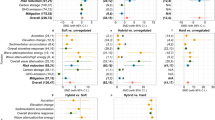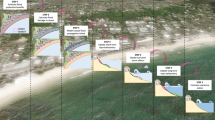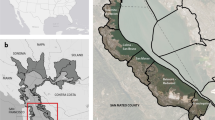Abstract
The use of combined approaches to coastal adaptation in lieu of a single strategy, such as sea-wall construction, allows for better preparation for a highly uncertain and dynamic coastal environment. Although general principles such as mainstreaming and no- or low-regret options exist to guide coastal adaptation and provide the framework in which combined approaches operate, few have examined the interactions, synergistic effects and benefits of combined approaches to adaptation. This Perspective provides three examples of ecological engineering — marshes, mangroves and oyster reefs — and illustrates how the combination of ecology and engineering works.
This is a preview of subscription content, access via your institution
Access options
Subscribe to this journal
Receive 12 print issues and online access
$209.00 per year
only $17.42 per issue
Buy this article
- Purchase on Springer Link
- Instant access to full article PDF
Prices may be subject to local taxes which are calculated during checkout


Similar content being viewed by others
References
Cheong, S. Guest editorial on coastal adaptation. Climatic Change 106, 1–4 (2011).
Brown, C. The end of reliability. J. Water Res. Plan. Manage. 136, 143–145 (2010).
Matthews, J. H. & Wickel, A. J. Embracing uncertainty in freshwater climate change adaptation: A natural history approach. Clim. Dev. 1, 269–279 (2009).
IPCC Managing the Risks of Extreme Events and Disasters to Advance Climate Change Adaptation (eds Field, C. B. et al.) (Cambridge Univ. Press, 2012).
IPCC in Managing the Risks of Extreme Events and Disasters to Advance Climate Change Adaptation (eds Field, C.B. et al.) 1–19 (Cambridge Univ. Press, 2012).
Nicholls, R. J., Wong, P. P., Burkett, V., Woodroffe, C. D. & Hay, J. Climate change and coastal vulnerability assessment: Scenarios for integrated assessment. Sustain. Sci. 3, 89–102 (2008).
Harvey, N., Clarke, B., Pelton, N. & Mumford, T. in Sustainable Coastal Management and Climate Adaptation: Global Lessons from Regional Approaches in Australia (eds Kenchington, R., Stocker, L. & Wood, D.) Ch. 4 (CRC, 2012).
Martinez, G., Bizikova, L., Blobel, D. & Swart R. in Global Change and Baltic Coastal Zones Vol. 1 (eds Schernewski, G., Hofstede, J. & Neumann, T.) Ch. 15 (Springer, 2011).
Ibrahim, H. S. & Shaw, D. Assessing progress toward integrated coastal zone management: Some lessons from Egypt. Ocean Coast. Manage. 58, 26–35 (2012).
World Bank Climate Change Team in Mainstreaming Adaptation to Climate Change in Agriculture and Natural Resources Management Projects Guidance Note 6 (World Bank, 2012); available via http://go.nature.com/oT4v7p
Heltberg, R., Siegel, P. B. & Jorgensen, S. L. Addressing human vulnerability to climate change: Toward a 'no-regrets' approach. Glob. Environ Change 19, 89–99 (2009).
Jones, H. P., Hole, D. G. & Zavaleta E. S. Harnessing nature to help people adapt to climate change. Nature Clim. Change 2, 504–509 (2012).
Council directive 92/43/EEC of 21 May 1992 on the conservation of natural habitats and of wild fauna and flora. EUR-Lex 35, L206 (1992).
Council directive 2009/147/EC of the European Parliament and of the Council of 30 November 2009 on the conservation of wild birds. EUR-Lex 53, L20 (2010).
Pilarczyk, K. W. Dikes and Revetments: Design, Maintenance and Safety Assessment (A. A. Balkema, 1998).
Pilkey, O. H. & Wright, H. L. Seawalls versus beaches. J. Coastal Res. 4, 41–64 (1988).
Hall, M. J. & Pilkey, O. H. Effects of hard stabilization on dry beach width for New Jersey. J. Coastal Res. 7, 771–785 (1991).
Matthews, J. H., Wickel, B. A. & Freeman, S. Converging currents in climate-relevant conservation: Water, infrastructure, and institutions. PLoS Biology 9, e1001159 (2011).
Mitsch, W. J. & Jørgensen, S. E. Ecological engineering: A field whose time has come. Ecol. Eng. 20, 363–377 (2003).
Roy, E. D., Martin, J. F., Irwin, E. G., Conroy, J. D. & Culver, D. A. Living within dynamic social-ecological freshwater systems: System parameters and the role of ecological engineering. Ecol. Eng. 37, 1661–1672 (2011).
Halpern, B. S., Silliman, B. R., Olden, J., Bruno, J. & Bertness, M. D. Incorporating positive interactions in aquatic restoration and conservation. Front. Ecol. Environ. 5, 153–160 (2007).
Campbell, A. et al. in Review of the Literature on the Links between Biodiversity and Climate Change: Impacts, Adaptation and Mitigation (eds Campbell, A. et al.) 49–87 (Secretariat of the Convention on Biological Diversity, 2009).
Gedan, K. & Silliman, B. R. Using facilitation theory to enhance mangrove restoration. Ambio 38, 109 (2009).
Van der Heide, T. et al. Three-stage symbiosis forms the foundation of seagrass ecosystems. Science 336, 1432–1434 (2012).
Borsje, B. W. et al. How ecological engineering can serve in coastal protection. Ecol. Eng. 37, 113–122 (2011).
Van Slobbe, E. et al. Building with nature: In search of resilient storm surge protection strategies. Nat. Hazards 65, 947–966 (2012).
Kirwan, M. L. et al. Limits on the adaptability of coastal marshes to rising sea level. Geophys. Res. Lett. 37, L23401 (2010).
Silliman, B. R. et al. Degradation and resilience in Louisiana salt marshes after the BP-Deepwater Horizon oil spill. Proc. Natl Acad. Sci. USA 109, 11234–11239 (2012).
Möller, I. & Spencer, T. Wave dissipation over macro-tidal saltmarshes: Effects of marsh edge typology and vegetation change. J. Coastal Res. SI36, 506–521 (2002).
Minello, K. A., Weintstein, M. & Hays, C. Salt marshes as nurseries for nekton: Testing hypotheses on density, growth and survival through meta analysis. Mar. Ecol. Prog. Ser. 236, 39–59 (2003).
Barbier, E. B. et al. The value of estuarine and coastal ecosystem services. Ecol. Monogr. 81, 169–193 (2011).
Mcleod, E. et al. A blueprint for blue carbon: Towards an improved understanding of the role of vegetated coastal habitats in sequestering CO2 . Front. Ecol. Environ. 9, 552–560 (2011).
Bertness, M. D., Ewanchuk, P. J. & Silliman, B. R. Anthropogenic modification of New England salt marsh landscapes. Proc. Natl Acad. Sci. USA 99, 1395–1398 (2002).
Wong, P. P. in Coastal Zones and Climate Change (eds Michel, D. & Pandya, A.) 69–83 (Stimson, 2010).
Cochard, R. et al. The 2004 tsunami in Aceh and Southern Thailand: A review on coastal ecosystems, wave hazards and vulnerability. Perspect. Plant Ecol. 10, 3–40 (2008).
Alongi, D. M. Mangrove forests: Resilience, protection from tsunamis, and responses to global climate change. Estuar. Coast Shelf Sci. 76, 1–13 (2008).
Tanaka, N. Vegetation bioshields for tsunami mitigation: Review of effectiveness, limitations, construction, and sustainable development. Landsc. Ecol. Eng. 5, 71–79 (2009).
McLeod, E. & Salm, R. V. Managing Mangroves for Resilience to Climate Change (IUCN, 2006).
McKee, K. L., Cahoon, D. R. & Feller, I. C. Caribbean mangroves adjust to rising sea level through biotic controls on change in soil elevation. Glob. Ecol. Biogeogr. 16, 545–556 (2007).
Huxham, M. et al. Intra and inter-specific facilitation in mangroves may increase resilience to climate change threats. Phil. Trans. R. Soc. B 365, 2127–2135 (2010).
Sengupta, S. In silt, Bangladesh sees potential shield against sea-level rise. New York Times (19 March 2009); available via http://go.nature.com/5GylEh
Reker, J. et al. Deltas on the Move: Making Deltas Cope with the Effects of Climate Change Report 001/2006 (National Research Programme Climate Change Spatial Planning, 2006).
Chua, G. Saving Tekong's coastal greenery. The Straits Times (12 May 2010); available via http://go.nature.com/hRe77s
Donato, D. C. et al. Mangroves among the most carbon-rich forests in the tropics. Nature Geosci. 4, 293–297 (2011).
Schmitt, K., Albers, T., Pham, T. T. & Dinh, S. C. Site-specific and integrated adaptation to climate change in the coastal mangrove zone of Soc Trang Province, Viet Nam. J. Coastal Conserv. http://dx.doi.org/10.1007/s11852-013-0253-4 (2013).
Winterwerp, J. C., Erftemeijer, P. L. A., Suryadiputra, N., van Eijk, P. & Zhang, L. Defining eco-morphodynamic requirements for rehabilitating eroding mangrove-mud coasts. Wetlands 33, 515–526 (2012).
Mukhtar, I. & Hannan, A. Constraints on mangrove forests and conservation projects in Pakistan. J. Coastal Conserv. 16, 51–62 (2012).
Tran, T. T. H., van Dijk, H. & Bush, S. R. Mangrove conservation or shrimp farmer's livelihood? The devolution of forest management and benefit sharing in the Mekong Delta, Vietnam. Ocean Coast. Manage. 69, 185–193 (2012).
Marani, M., d'Alpaos, A., Lanzoni, S. & Santalucia, M. Understanding and predicting wave erosion of marsh edges. Geophys. Res. Lett. 38, L21401 (2011).
Scyphers, S. B., Powers, S. P., Heck, K. L. & Byron, D. Oyster reefs as natural breakwaters mitigate shoreline loss and facilitate fisheries. PLoS ONE 6, e22396 (2011).
Kim, C-K., Park, K. & Powers, S. P. Establishing restoration strategy of Eastern Oyster via a coupled biophysical transport model. Restor. Ecol. 21, 353–362 (2012).
Dean, R. G., Chen, R. & Browder, A. E. Full scale monitoring study of a submerged breakwater, Palm Beach, Florida, USA. Coast. Eng. 29, 291–315 (1997).
Ranasinghe, R. & Turner, I. Shoreline response to submerged structures: A review. Coast. Eng. 53, 65–79 (2006).
Ranasinghe, R., Larson, M. & Savioli, J. Shoreline response to a single shore-parallel submerged breakwater. Coast. Eng. 57, 1006–1017 (2010).
Cáceres, I., Sánchez-Arcilla, A., Alsina, J. M., González-Marco, D. & Sierra, J. P. in Coastal Dynamics 2005: State of the Practice (ed. Sanchez-Arcilla, A.) http://dx.doi.org/10.1061/40855(214)53 (American Society of Civil Engineers, 2006).
Campbell, M. D. Analysis and Evaluation of a Bioengineered Submerged Breakwater MSc thesis, Louisiana State Univ. (2004); available via http://go.nature.com/LYl2OY
Allen, R. J. & Webb, B. M. in Coastal Engineering Practice (eds Magoon, O. T., Noble, R. M., Treadwell, D. D. & Kim. Y. C.) 684–697 (ASCE, 2011).
Van der Meer, J. W., Briganti, R., Zanuttigh, B. & Wang, B. Wave transmission and reflection at low crested structures: Design formulae, oblique wave attack and spectral change. Coast. Eng. 52, 915–929 (2005).
Peterson, C. H. & Lipcius, R. N. Conceptual progress towards predicting quantitative ecosystem benefits of ecological restoration? Mar. Ecol. Prog. Ser. 264, 297–307 (2003).
Coen, L. D. et al. Ecosystem services related to oyster restoration. Mar. Ecol. Prog. Ser. 341, 303–307 (2007).
Beck, M. W. et al. Oyster reefs at risk and recommendations for conservation, restoration and management. BioScience 61, 107–116 (2011).
Coen, L. D., Luckenbach, M. W. & Breitburg, D. L. in Fish Habitat: Essential Fish Habitat and Rehabilitation (ed. Benaka, L. R.) 438–454 (American Fisheries Society, 1999).
Kroeger, T. Dollars and Sense: Economic Benefits and Impacts from Two Oyster Reef Restoration Projects in the Northern Gulf of Mexico (Nature Conservancy, 2012).
Acknowledgements
We thank Jess Silver and Megan Holroyd for their assistance.
Author information
Authors and Affiliations
Corresponding author
Ethics declarations
Competing interests
The authors declare no competing financial interests.
Rights and permissions
About this article
Cite this article
Cheong, SM., Silliman, B., Wong, P. et al. Coastal adaptation with ecological engineering. Nature Clim Change 3, 787–791 (2013). https://doi.org/10.1038/nclimate1854
Received:
Accepted:
Published:
Issue Date:
DOI: https://doi.org/10.1038/nclimate1854
This article is cited by
-
Overview on Mangrove Forest Disaster Prevention and Mitigation Functions
Journal of Ocean University of China (2024)
-
Putative Local Adaptive SNPs in the Genus Avicennia
Biochemical Genetics (2023)
-
Protection and restoration of coastal habitats yield multiple benefits for urban residents as sea levels rise
npj Urban Sustainability (2022)
-
Assessment of suitable habitat of mangrove species for prioritizing restoration in coastal ecosystem of Sundarban Biosphere Reserve, India
Scientific Reports (2022)
-
Wave attenuation through forests under extreme conditions
Scientific Reports (2022)



